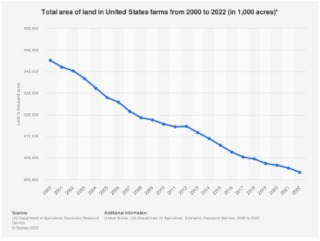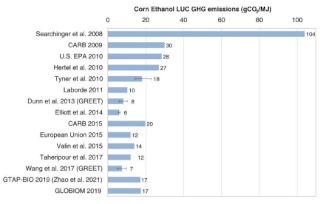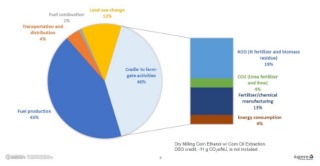
Acre Change from 1997 to 2022
The 2022 Agricultural Census reported 880 million acres of land in US farms, or 75 million fewer acres than the 1997 Agricultural Census (see Figure 2). Cropland and woodland declined by roughly -5 million acres while pastureland declined by -65 million acres. Pastureland accounted for 88% of the total decline. Definitions are nearly identical between 1997 and 2022 (see Data Note 1). Therefore, a change in definition is not explaining the decline of land in US farms.

Percent Change from 1997 to 2022
Since the number of acres varies substantially by land use category, it is important to also look at percent change in acres. There were 8% fewer acres of land in US farms in 2022 than in 1997 (see Figure 3). Pastureland had the largest percent loss, -13%. Percent decline was roughly half as large for woodland, -6%; but only -2% for cropland. As a result of these differential percent changes between 1997 and 2022, cropland’s share of land in farms increased from 34% to 36% while pastureland’s share declined from 52% to 49%.
Discussion
Since the 1996 Farm Bill’s seminal policy change that gave farmers the freedom to decide which crops to plant or not plant, land in US farms has declined by 75 million acres or -8%.
Most (88%) of the decline occurred in pastureland. It is thus incorrect to equate the loss of farmland to a loss of cropland. Cropland has declined by only -2% while pastureland has declined by -13%.
The decline in cropland is consistent with farmers being given the freedom to decide not to plant land and yet continue to receive farm commodity program payments.
The sizable decline in pastureland is consistent with the growth in confinement animal production.
The changes discussed in this paper are net changes. Anecdotal evidence suggests cropland lost to farm production is being replaced by the conversation of pastureland to cropland. Net result of these two changes is a loss of pastureland. Additional study is needed to document the exact pathway(s) by which pastureland is loss.
Woodland, the other major land-in-farm category, declined by -6% from 1997 to 2022. Understanding the pathways of this loss also needs additional study, especially given current concerns over climate change and the potential ability for trees to sequester carbon.
The next article will examine the loss of land in US farms across US regions.
Data Note 1:
Census explanation of “land in farms” in the 2022 Census of Agriculture:
“The acreage designated as ‘‘land in farms’’ consists primarily of agricultural land used for crops, pasture, or grazing. It also includes woodland and wasteland not actually under cultivation or used for pasture or grazing, provided it was part of the farm producer’s total operation. Large acreages of woodland or wasteland held for nonagricultural purposes were deleted from individual reports during the edit process. Land in farms includes CRP, WRP, FWP, and CREP acres. Land in farms is an operating unit concept and includes land owned and operated as well as land rented from others. Land used rent free was reported as land rented from others. All grazing land, except land used under government permits on a per-head basis, was included as ‘‘land in farms’’ provided it was part of a farm or ranch. Land under the exclusive use of a grazing association was reported by the grazing association and included as land in farms. All land in American Indian reservations used for growing crops, grazing livestock, or with the potential of grazing livestock was included as land in farms. Land in reservations not reported by reservation, individual American Indians, or non-Native Americans was reported in the name of the cooperative group that used the land. In a few instances, an entire American Indian reservation was reported as one farm.”
Census explanation of “land in farms” in the 1997 Census of Agriculture:
“The acreage designated as ‘‘land in farms’’ consists primarily of agricultural land used for crops, pasture, or grazing. It also includes woodland and wasteland not actually under cultivation or used for pasture or grazing, provided it was part of the farm operator’s total operation. Large acreages of woodland or wasteland held for nonagricultural purposes were deleted from individual reports during the processing operations. Land in farms includes acres in the Conservation Reserve and Wetlands Reserve Programs. Land in farms is an operating unit concept and includes land owned and operated as well as land rented from others. Land used rent free was to be reported as land rented from others. All grazing land, except land used under government permits on a per-head basis, was included as ‘‘land in farms’’ provided it was part of a farm or ranch. Land under the exclusive use of a grazing association was to be reported by the grazing association and included as land in farms. All land in American Indian reservations used for growing crops or grazing livestock was to be included as land in farms. Land in reservations not reported by individual American Indians or non-Native Americans was to be reported in the name of the cooperative group that used the land. In many instances, an entire American Indian reservation was reported as one farm.”
Source : illinois.edu